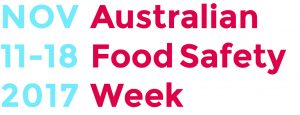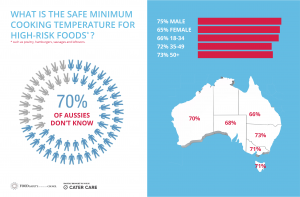
Despite celebrity cooking shows being all the rage, the Food Safety Information Council released a national survey today for Australian Food Safety Week that shows that the majority of Australians surveyed have no idea of safe

cooking temperatures for high-risk foods such as hamburgers, sausages and poultry.
Food Safety Information Council Chair, Rachelle Williams, said that the Council was amazed that 70% of those surveyed reported that they didn’t know the safe cooking temperature for these high-risk foods.
‘Even worse, of those that reported they did know the correct temperature, most were wrong with 15% saying below the safe temperature of 75°C and 9% stating it should be 100°C or more, which would be a pretty burnt piece of food.
‘Coupled with this lack of knowledge is another of our surveys which found 75% of Australians surveyed reported that there wasn’t a meat thermometer in their household and only 44% of those with a thermometer reported using is over the previous month.
‘With an estimated 4.1 million cases of food poisoning in Australia each year, and escalating rates of Campylobacter and Salmonella infection in Australia, we are encouraging all Australians to pick up a food thermometer from their local homeware store and learn how to use it properly. This will not only ensure safer food but you will also be able to cook the perfect steak.
‘You should place the food thermometer in the thickest part of the food. As close to the centre as possible and it should not touch bone, fat, or gristle. Start checking the temperature toward the end of cooking, but before you expect it to be done. Be sure to clean the stem of your food thermometer before and after each use.
The Council recommends these temperatures for cooking these high-risk foods safely:
- Red meat or pork that is minced, stuffed, rolled or boned or is mechanically tenderised (with small holes in the surface to penetrate into the meat) or corned beef pumped with brine using needles will be contaminated by bacteria throughout so must be cooked to 75°C in the centre. This also applies to red meat livers.
- Any poultry such as chicken, ducks or turkey (including their livers) will also be contaminated throughout whether they are whole or minced so they must be cooked to 75°C in the thickest part near the centre.
- Leftovers should be reheated to 75°C in the centre and make sure they are stirred to ensure an even temperature
- Eggs and egg dishes, such as quiche, should be cooked until 72 °C in the centre (or until the white is firm and the yolk thickens)
These foods will only have contamination on the outside so can be cooked to your taste:
- Red meat in whole cuts, such as steaks, chops, pieces and whole roasts, make sure the surface is well browned and cook the centre to your taste. As a guide: well done is 77°C, medium 71°C and medium rare 63 °C (leave to rest for 3 minutes)
- Pork in whole cuts can be cooked like red meat, but is better quality if pork steaks and pieces are cooked to 70°C and roasts to between 70°C and 75°C
- Fish fillets can be cooked to around 69°C or when flesh flakes easily.
‘These tips can be downloaded in poster form from our website which we suggest you stick up in your kitchen. Use a thermometer for great food, cooked safely every time,’ Ms Williams concluded.
There is more information about Australian Food Safety Week 2017 here including an online quiz and fact sheet.
The Food Safety Information Council would like to thank Queensland Health, the Australian Chicken Meat Federation, Cater Care, the Department of Health and Human Services Tasmania, Elanco Australasia and Media Heads for their support in making Australian Food Safety Week 2017 possible.
Media contact: Lydia Buchtmann 0407 626 688, info@foodsafety.asn.au
Australian Food Safety Week is the major activity of the Food Safety Information Council which is a health promotion charity that aims to reduce the estimated 4.1 million cases of food borne illness in Australia each year. Food poisoning results, on average, in 120 deaths, 1.2 million visits to doctors, 300,000 prescriptions for antibiotics, and 2.1 million days of lost work each year. The estimated annual cost of food poisoning in Australia is $1.25 billion.
